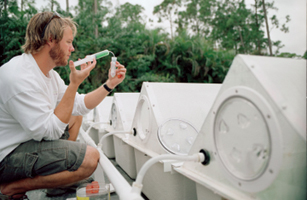
PRECISION GROWTH: Algenol biologist Jesse Phillips-Kress tests an algae strain from the company's sun-absorbing bioreactors
(2 of 2)
Few companies have more experience in the practical work of breaking down cellulose than Denmark's Novozymes, the world's leading maker of industrial enzymes. Novozymes has traditionally manufactured enzymes for bio-industrial purposes like waste-water cleanup, but for the past several years the company has moved into biofuels — an initiative that is now the fastest-growing slice of its business. Novozymes employs enzyme hunters who scour the world to find the best bugs to digest cellulose. (It's messy work — compost piles are among the best places to search.) But why settle for what nature gives you when you can use the tools of biotechnology to build a better enzyme in the lab? At its research facility in Davis, Calif., Novozyme scientists are tweaking the genetic structures of selected enzymes to improve their ability to break down cellulose, a process called directed evolution. "Cellulose has evolved to resist degradation," says Lars Hansen, president of Novozymes North America. "But biotech is rising to that evolutionary challenge."
The Hope for Biotech
Even more promising, biotech may be able to manufacture a better biofuel. One of the disadvantages of ethanol is that standard automobile engines need to be retrofitted to burn it. What's more, ethanol is too corrosive to be transported through the pipelines that carry petroleum to market. But Amyris, based in Emeryville, Ca., is using genetic engineering to produce yeasts that can yield custom-designed, renewable fuels that have all the advantages of hydrocarbons — like ease of transport and high energy density — without the environmental drawbacks. "We want something that can drop into the existing infrastructure tomorrow," says Neil Renninger, Amyris' co-founder. The company opened a new pilot plant in November capable of producing 2.4 million gallons
(9 million L) of renewable diesel a year, and aims to manufacture 200 million gallons (900 million L) of fuel commercially by 2011.
There's just one problem: Amyris' designer fuels still depend on a food crop (right now it's sugarcane) as a feedstock. Although sugarcane is a much more efficient source of fuel than corn, it's still a food crop, and it's hard to see how Amyris could truly scale up its technology without impacting food supplies. But there could be a cheap, abundant alternative, one that has none of the inherent drawbacks of agricultural feedstocks: pond scum. Unlike even cellulosic ethanol, which requires farmland of some sort, garden-variety algae can be grown anywhere warm and sunny, and it can thrive in saline water rather than precious fresh water. Not only that, algae eats carbon — a lot of it. So algae-growing facilities could, theoretically, do double duty, as the source of a renewable biofuel and as an elegant answer to the question of where to sequester the carbon emitted by fossil-fuel plants. "We're looking at a product that spares land and water, and has an excellent energy-to-CO2 ratio," says Jason Pyle, CEO of San Diego-based company Sapphire Energy, one of the best funded start-ups in the biofuel field.
Nobody is more bullish on algae than Algenol's Woods, who founded the company in 2006 but has been pondering algae's potential since he came up with the basic idea behind Algenol's technology as an undergraduate in 1984. Most algae firms harvest the organisms and squeeze them to extract oil that's then processed into a fuel, but Algenol's strains essentially sweat oil in a gaseous form that can be condensed into a liquid. Woods says his system can yield 6,000 gallons (22,700 L) of ethanol per acre annually, compared to 370 gallons (1,400 L) per acre for corn ethanol. At his Florida test facility, Woods kneels and taps on one of his holding tanks. Clear droplets cling to the inside of the lid. "This is it," he says. "That's what we've learned here — this really does work."
Woods will soon get a chance to test his idea on a massive scale. With a group of partners that includes a scion of the Corona beer family, Algenol is poised to break ground on a commercial-scale facility in the Sonoran desert of northern Mexico. The plant's seaside location enables the company to use seawater to grow the algae, and a nearby coal plant could provide concentrated CO2 to turbocharge production. But not everyone is convinced that either algae or Algenol is ready for prime time. "I would say the hype is well ahead of the reality," says John Benemann, an expert in algae biofuels, who notes that no commercial method yet exists to capture CO2 from power plants and deliver it to algae facilities.
Of course, the hype exceeds the reality in nearly every facet of advanced biofuels, as it does throughout the world of alternative energy. The good news is that the technology to produce truly sustainable biofuels is advancing quickly. The bad news is that for now the business more closely resembles a science-fair project than Big Oil. Fixing that will require smart government policies — like favoring fuels based on their carbon footprint, not where they come from or who grows them. Says NRDC's Greene: "Biofuels might be the worst thing we can do — except for nothing."